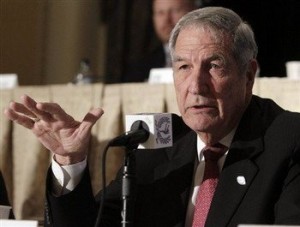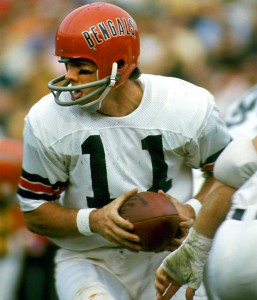by Chase Stuart
on July 10, 2012
When thinking about the 2012 Cowboys, it’s easy to focus on Dallas’ star offensive players. Unfortunately, that overshadows the fact that we’re witnessing the prime of the career of what will end up being the best 3-4 outside linebacker in the history of pro football.
There is nothing DeMarcus Ware could have done, or could do in the future, to convince most football fans that he ranks ahead of Lawrence Taylor in any all-time list. That’s not unique to Taylor; some would find it unfathomable to vault a cover corner over Deion Sanders, a middle linebacker over Dick Butkus, or a running back over Jim Brown. So let’s just get that out of the way. To many, ‘LT’ is the best 3-4 outside linebacker ever (if not best linebacker or defensive player, period) and that will never change. To them, this post won’t change your mind one bit. To others, allow me to make the case that when he retires, Ware will have been the best player to ever play his position.

The best 3-4 outside linebacker ever?
The 3-4 defense didn’t enter the NFL until 1974, when the scheme was brought to Houston, Buffalo and New England. Putting aside Taylor, the best outside linebackers to play in this scheme include names like Robert Brazile, Tom Jackson, Ted Hendricks, Clay Matthews, Andre Tippett, New Orleans’ Rickey Jackson and Pat Swilling, Kevin Greene, Greg Lloyd, Cornelius Bennett and Derrick Thomas. In today’s game, it’s probably Ware and Terrell Suggs, who also splits his time playing as a 4-3 end. With all due respect to Suggs, and other active stars like Tamba Hali, LaMarr Woodley and James Harrison, Aldon Smith, Clay Matthews and Cameron Wake, no current player has the body of work to compare to Ware.
The Cowboys star has been named an AP first-team All-Pro four times; among 3-4 outside linebackers, only Taylor has more selections. Taylor (10), Robert Brazile (7), Rickey Jackson (6) and Ware are the only 3-4 linebackers to have been named to six Pro Bowls, and Ware has been a selection in each of the last six years. Ultimately, outside of perhaps a vocal minority that would argue for Derrick Thomas over Taylor (and more on that tomorrow), Ware’s case as the best 3-4 outside linebacker of all-time comes down to whether you could put him ahead of Taylor as a player .
[continue reading…]
Tagged as:
1980s,
3-4 defense,
Cowboys,
DeMarcus Ware,
Giants,
Lawrence Taylor,
NFC East,
RPO 2012,
Sacks
{ }
by Chase Stuart
on June 27, 2012
Gene Stallings coached in the NFL in the late ’80s, in between the Jim Hanifan and Joe Bugel eras of Cardinals football. He was the man who led the team as the franchise relocated from St. Louis to Phoenix. He coached under Tom Landry for over a decade in Dallas. But Gene Stallings will always be remembered for working under Bear Bryant and for embodying what it meant to coach Alabama football.
Stallings played on Bryant’s famous Junction Boys team at Texas A&M, and coached under Bryant when the Crimson Tide won national championships in ’61 and ’64. After his failed stint in the NFL, Stallings returned to Alabama, this time as the head coach. His crowning achievement was winning the 1992 national championship, capping a 13-0 season.
So why the background on Stallings today? One of the fun things about owning a website is seeing where your traffic comes from. I noticed a bunch of hits were coming from RollBamaRoll.com. So I went to the site to see what was driving the traffic (as it turns out, a random link to this passer rating article) and I found this great quote by Stallings on another page:
Everyone keeps talking about our game with Miami [in the 1993 Sugar Bowl]. The reason we won against Miami is this: We had the ball 15 minutes more than they did. We ran the ball for 275 yards against Miami. They ran the ball for less than 50 yards. When the game was over, we won. After a game, it may not look good. The alumni may be asking why we are not entertaining them. Let me assure you that our job is to win football games. You win football games by running the ball, stopping the run and being on the plus side of giveaway-takeaways.

You get five pass attempts and no more.
I think every coach at every level has, at some point, uttered a phrase to essentially the same effect. It is quintessential Alabama football, but it could have just as easily come out of the mouth of
Greasy Neale or
Bill Cowher or
Vince Lombardi. Of course, whenever I read a quote like that, two immediate questions come to mind. Is it true? And how can I determine if it’s true?
[continue reading…]
Tagged as:
Alabama,
Crimson Tide,
Gene Stallings
{ }
by Chase Stuart
on June 25, 2012

Jimmy Graham's invisible mirror displays his uniform as aesthetically pleasing
Last year, Jimmy Graham broke Kellen Winslow’s record for receiving yards in a single season by a tight end. Winslow gained 1,290 yards as a second-year player in 1980 for the San Diego Chargers. Last year, Graham finished with 1,310 receiving yards in his second season, while also catching 99 passes and scoring 11 touchdowns. Graham broke Winslow’s 31-year-old record, but Graham was leapfrogged in about fifteen minutes. By the end of the last Sunday of the regular season, Rob Gronkowski had upped his total to 1,327 yards, making him the new single-season leader in receiving yards and receiving touchdowns by a tight end.
Jason Witten and Aaron Hernandez each topped 900 receiving yards in 2011, and Tony Gonzalez, Antonio Gates and Vernon Davis remain among the game’s elite at the position. It would not be difficult to argue that we’re in a golden age of tight ends. There’s no doubt that passing has increased in both quantity and quality; have tight ends been the biggest beneficiaries of that change?
I examined every season in the NFL since 1970, when the AFL and NFL merged. I then calculated the percentage of receiving yards for each team that went to its running backs, tight ends and wide receivers. The table below shows those results.
[continue reading…]
Tagged as:
1978 Rules Changes,
Jimmy Graham,
Rob Gronkowski,
Tight Ends
{ }
by Chase Stuart
on June 21, 2012
Yesterday, I began looking at how the 12 expansion teams of the modern era fared during their first 13 years of existence. Today, the bottom half of the list:
#6 Cincinnati Bengals (1968-1980)
Art Modell purchased the Browns in 1961; Modell and Paul Brown, the only coach the franchise had ever known, clashed almost immediately. In January 1963, Modell fired Brown, who began plotting his revenge almost immediately. At the time, the AFL was gaining traction, but Brown had no desire to be in a “lesser” league. By the time the AFL had decided to add Cincinnati as an expansion franchise, the AFL and NFL had already agreed to merge prior to the start of the 1970 season. Brown was part of the ownership group that brought the Bengals into professional football, and became the team’s first head coach. One of his first decisions? Hiring a young Bill Walsh.
The Bengals played like a typical expansion team in 1968, but their hopes seemed to change the following season. With the 5th pick in the 1969 draft , Brown didn’t have to look far: he selected Cincinnati signal caller Greg Cook. The former Bearcat was an immediate star: his 9.4 yards per attempt average remains the highest ever by a rookie quarterback with at least 175 pass attempts. Cook led the AFL in completion percentage, yards per attempt and quarterback rating, but was mostly known for his powerful arm. His 17.5 yards per completion average that season has only been bested once since, and it remains the 12th highest mark in league history. Making the season more incredible was that Cook tore his rotator cuff against the Chiefs… in week three. Following surgery to repair his shoulder, Cook threw just three more passes, prompting many to wonder how great he could have been.

They're never going to expect the shallow cross.
Tagged as:
Browns,
Expansion
{ }
by Chase Stuart
on June 20, 2012
Thirteen years ago, the Cleveland Browns were preparing for their return to the NFL. The Browns were the dominant team of the ’50s and were a consistent playoff contender for much of the ’60s and ’80s. In 1996, Art Modell took the Browns to Baltimore and renamed them the Ravens. Three years later, the NFL gave the city of Cleveland an expansion franchise; unfortunately, the new Browns have struggled to find an identity or a direction for much of their first thirteen seasons.
Consider: since 1999, the Browns have the second worst record in football, trailing only the Detroit Lions. Cleveland has scored the fewest points in the league and been outscored by the most points since returning to the NFL. The Browns have been shutout 12 times, by far the most in the league over that span. The Browns and the Bills are the only teams to appear in only one playoff game since 1999, with neither team being victorious.
Symptomatic of the Browns’ failure to build a competitive team is the constant turnover at the most important positions. Assuming rookie Brandon Weeden starts in week one, he’ll be the 11th quarterback to start the season opener for the new Browns, and the sixth in six years. Pat Shurmur is Cleveland’s sixth head coach since returning to the league; Brad Childress is now their ninth offensive coordinator/play caller.
How do the Browns rank compared to other expansion teams? The Bears, Cardinals, Packers, Giants, Lions, Redskins, Steelers, Eagles and Rams all entered the league before 1940, making an apples-to-apples comparison impossible. The 49ers and Browns (v.1.0) entered the NFL from the All America Football Conference, so they weren’t expansion teams when they joined the NFL. The Baltimore Colts and their complicated history are probably best left off this list.
[continue reading…]
Tagged as:
Browns,
Expansion
{ }




